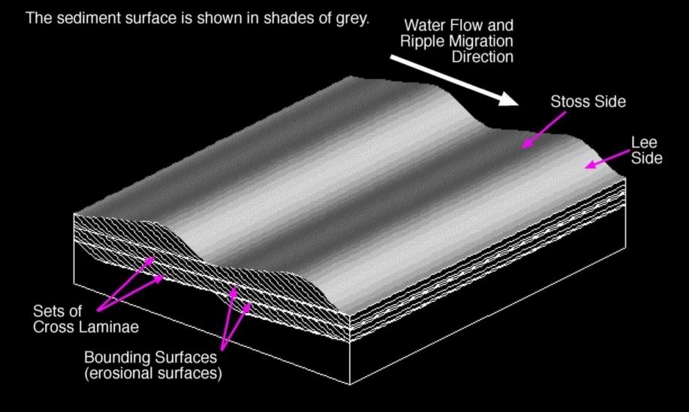7.3.1: USGS Bedform Movie Explanation
- Page ID
- 4048
\( \newcommand{\vecs}[1]{\overset { \scriptstyle \rightharpoonup} {\mathbf{#1}} } \)
\( \newcommand{\vecd}[1]{\overset{-\!-\!\rightharpoonup}{\vphantom{a}\smash {#1}}} \)
\( \newcommand{\id}{\mathrm{id}}\) \( \newcommand{\Span}{\mathrm{span}}\)
( \newcommand{\kernel}{\mathrm{null}\,}\) \( \newcommand{\range}{\mathrm{range}\,}\)
\( \newcommand{\RealPart}{\mathrm{Re}}\) \( \newcommand{\ImaginaryPart}{\mathrm{Im}}\)
\( \newcommand{\Argument}{\mathrm{Arg}}\) \( \newcommand{\norm}[1]{\| #1 \|}\)
\( \newcommand{\inner}[2]{\langle #1, #2 \rangle}\)
\( \newcommand{\Span}{\mathrm{span}}\)
\( \newcommand{\id}{\mathrm{id}}\)
\( \newcommand{\Span}{\mathrm{span}}\)
\( \newcommand{\kernel}{\mathrm{null}\,}\)
\( \newcommand{\range}{\mathrm{range}\,}\)
\( \newcommand{\RealPart}{\mathrm{Re}}\)
\( \newcommand{\ImaginaryPart}{\mathrm{Im}}\)
\( \newcommand{\Argument}{\mathrm{Arg}}\)
\( \newcommand{\norm}[1]{\| #1 \|}\)
\( \newcommand{\inner}[2]{\langle #1, #2 \rangle}\)
\( \newcommand{\Span}{\mathrm{span}}\) \( \newcommand{\AA}{\unicode[.8,0]{x212B}}\)
\( \newcommand{\vectorA}[1]{\vec{#1}} % arrow\)
\( \newcommand{\vectorAt}[1]{\vec{\text{#1}}} % arrow\)
\( \newcommand{\vectorB}[1]{\overset { \scriptstyle \rightharpoonup} {\mathbf{#1}} } \)
\( \newcommand{\vectorC}[1]{\textbf{#1}} \)
\( \newcommand{\vectorD}[1]{\overrightarrow{#1}} \)
\( \newcommand{\vectorDt}[1]{\overrightarrow{\text{#1}}} \)
\( \newcommand{\vectE}[1]{\overset{-\!-\!\rightharpoonup}{\vphantom{a}\smash{\mathbf {#1}}}} \)
\( \newcommand{\vecs}[1]{\overset { \scriptstyle \rightharpoonup} {\mathbf{#1}} } \)
\( \newcommand{\vecd}[1]{\overset{-\!-\!\rightharpoonup}{\vphantom{a}\smash {#1}}} \)
\(\newcommand{\avec}{\mathbf a}\) \(\newcommand{\bvec}{\mathbf b}\) \(\newcommand{\cvec}{\mathbf c}\) \(\newcommand{\dvec}{\mathbf d}\) \(\newcommand{\dtil}{\widetilde{\mathbf d}}\) \(\newcommand{\evec}{\mathbf e}\) \(\newcommand{\fvec}{\mathbf f}\) \(\newcommand{\nvec}{\mathbf n}\) \(\newcommand{\pvec}{\mathbf p}\) \(\newcommand{\qvec}{\mathbf q}\) \(\newcommand{\svec}{\mathbf s}\) \(\newcommand{\tvec}{\mathbf t}\) \(\newcommand{\uvec}{\mathbf u}\) \(\newcommand{\vvec}{\mathbf v}\) \(\newcommand{\wvec}{\mathbf w}\) \(\newcommand{\xvec}{\mathbf x}\) \(\newcommand{\yvec}{\mathbf y}\) \(\newcommand{\zvec}{\mathbf z}\) \(\newcommand{\rvec}{\mathbf r}\) \(\newcommand{\mvec}{\mathbf m}\) \(\newcommand{\zerovec}{\mathbf 0}\) \(\newcommand{\onevec}{\mathbf 1}\) \(\newcommand{\real}{\mathbb R}\) \(\newcommand{\twovec}[2]{\left[\begin{array}{r}#1 \\ #2 \end{array}\right]}\) \(\newcommand{\ctwovec}[2]{\left[\begin{array}{c}#1 \\ #2 \end{array}\right]}\) \(\newcommand{\threevec}[3]{\left[\begin{array}{r}#1 \\ #2 \\ #3 \end{array}\right]}\) \(\newcommand{\cthreevec}[3]{\left[\begin{array}{c}#1 \\ #2 \\ #3 \end{array}\right]}\) \(\newcommand{\fourvec}[4]{\left[\begin{array}{r}#1 \\ #2 \\ #3 \\ #4 \end{array}\right]}\) \(\newcommand{\cfourvec}[4]{\left[\begin{array}{c}#1 \\ #2 \\ #3 \\ #4 \end{array}\right]}\) \(\newcommand{\fivevec}[5]{\left[\begin{array}{r}#1 \\ #2 \\ #3 \\ #4 \\ #5 \\ \end{array}\right]}\) \(\newcommand{\cfivevec}[5]{\left[\begin{array}{c}#1 \\ #2 \\ #3 \\ #4 \\ #5 \\ \end{array}\right]}\) \(\newcommand{\mattwo}[4]{\left[\begin{array}{rr}#1 \amp #2 \\ #3 \amp #4 \\ \end{array}\right]}\) \(\newcommand{\laspan}[1]{\text{Span}\{#1\}}\) \(\newcommand{\bcal}{\cal B}\) \(\newcommand{\ccal}{\cal C}\) \(\newcommand{\scal}{\cal S}\) \(\newcommand{\wcal}{\cal W}\) \(\newcommand{\ecal}{\cal E}\) \(\newcommand{\coords}[2]{\left\{#1\right\}_{#2}}\) \(\newcommand{\gray}[1]{\color{gray}{#1}}\) \(\newcommand{\lgray}[1]{\color{lightgray}{#1}}\) \(\newcommand{\rank}{\operatorname{rank}}\) \(\newcommand{\row}{\text{Row}}\) \(\newcommand{\col}{\text{Col}}\) \(\renewcommand{\row}{\text{Row}}\) \(\newcommand{\nul}{\text{Nul}}\) \(\newcommand{\var}{\text{Var}}\) \(\newcommand{\corr}{\text{corr}}\) \(\newcommand{\len}[1]{\left|#1\right|}\) \(\newcommand{\bbar}{\overline{\bvec}}\) \(\newcommand{\bhat}{\widehat{\bvec}}\) \(\newcommand{\bperp}{\bvec^\perp}\) \(\newcommand{\xhat}{\widehat{\xvec}}\) \(\newcommand{\vhat}{\widehat{\vvec}}\) \(\newcommand{\uhat}{\widehat{\uvec}}\) \(\newcommand{\what}{\widehat{\wvec}}\) \(\newcommand{\Sighat}{\widehat{\Sigma}}\) \(\newcommand{\lt}{<}\) \(\newcommand{\gt}{>}\) \(\newcommand{\amp}{&}\) \(\definecolor{fillinmathshade}{gray}{0.9}\)David M. Rubin, from the USGS Western Region Coastal and Marine Geology Program at Menlo Park, CA, published a book called Cross-Bedding, Bedforms, and Paleocurrents, which is available from SEPM and online at http://walrus.wr.usgs.gov/seds/bedforms/. He has posted some movies on the web site which demonstrate how various types of cross stratification are created. We will use these movies in lab to help interpret various styles of cross stratification.
First, here is an explanation of what you see in the movies:

The computer model that generated these movies starts with a bedform shape, which is constant throughout the movie. It is defined by the grey shaded surface. "Laminae" are deposited by moving the surface downstream and slightly up for each time step. Deposited laminae are represented by white lines. If the surface intersects the laminae, they are eroded, just like if laminae are exposed to an erosive current, they are eroded. Thus, the laminae change length and geometry as the "bedform" (surface) migrates.
All the movies associated with the publication are all listed at http://walrus.wr.usgs.gov/seds/bedforms/animation-toc.html. They are categorized by the shapes of the bedforms and photographs of real bedforms are also included. This is an EXCELLENT resource.
Start with a movie of real current ripples in an experimental flume. This will give you a sense of how irregular ripples can be. (Drag the marker at the bottom of the movie to go back to a specific place. Click on the play button to rerun the movie.)
Here is a model-produced version of the migration of a linear ripple or dune: http://walrus.wr.usgs.gov/seds/bedforms/movie_pages/movie5.html
Here is a model-produced version of the migration of a sinuous ripple or dune: http://walrus.wr.usgs.gov/seds/bedforms/movie_pages/movie34a.html This movie ends with the top surface of the ripples/dunes getting eroded flat. The white lines represent the laminae that intersect the upper surface. Note how complexly shaped they are. Next the cross stratification is rotated to show how different surfaces show different cross stratification styles. Drag the marker at the bottom of the movie back and forth to explore these variations. Note how important it is to have a 3-D view of the cross stratification to interpret bedform geometry even when it is relatively simple!
One goal of the modeling effort is to reproduce complex cross stratification that is observed in the field. The following movie produces a simplified version of cross stratification observed in a river bar. Here is movie that shows how the model can fit complicated structures observed in the field: http://walrus.wr.usgs.gov/seds/bedforms/morphs/fig46l-54morphMOVIE.mov.
This movie begins with a computer-animated sequence showing the origin of compound crossbedding. After the computer-generated structure is constructed and rotated through a variety of outcrop orientations, the image morphs into a natural outcrop of the same kind of structure. The natural example was photographed on a horizontal surface that was excavated into a fluvial bar in Grand Canyon. This movie is the best one for illustrating the origin of moderately complicated crossbedding.
Lots of other movies are available to explore as you wish. There are also LOTS of photos of different model-produced stratification styles and some outcrop photos associated with the online book. The USGS web site also provides software to make your own movies by defining a bedform geometry. Have fun! (Note there are a few problems with the input files. To get them to run, make sure each number has a comma after it, and remove the tab characters. I did figure it out, so ask me if you are interested.)
Return to the Sedimentary Structures Lab Page


